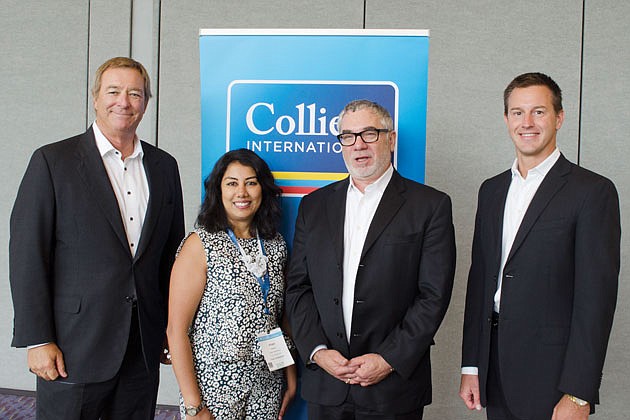Is traditional retail dead? On life support? Crumbling under the seemingly unstoppable juggernaut that is Amazon?
Not according to experts and participants at this year's International Council of Shopping Centers (ICSC) annual Florida confab, in Orlando.
Instead, they argue that change is a constant force in retail and has always been, and that it is a force that can be harnessed and used to one's advantage.
“The thing with retail is, a case can be made there's always been change, constant change,” says Lee Arnold, executive chairman and CEO of commercial real estate brokerage firm Colliers International Florida, during a keynote panel discussion.
He notes by way of example that 30 years ago, Kmart was a dominant discount retailer nationwide and throughout Florida, until it was, in turn, supplanted by Walmart.
But with roughly 3,000 store closings since the beginning of this year — by the likes of Bebe, Payless Shoe Source, Sears and others — and the continued growth of online shopping and technological innovation, Arnold and others contend change will not only continue, but accelerate.
“The rate of change in 2020 will be five times faster than what we've seen in the past two to three years,” Arnold says, the result of macro-economic and technological changes that will further transform the retail marketplace. “Physical stores are not going away, but they will change dramatically.”
He and other panelists note that Amazon's purchase of Whole Foods Market Inc. and Wal-Mart Stores' recently announced partnership with online behemoth Google will send further shockwaves through an already buffeted and beleagured industry.
Most of the bleeding, Colliers International Florida President Ryan Kratz believes, has been concentrated in apparel-reliant department stores, gas stations that have had to absorb lower fuel costs and electronics stores, which have been overrun by concepts such as “showrooming” — in which customers see something in a brick-and-mortar store only to buy it online typically at less cost.
In the arena of apparel, he blames the stores, and the fashion designers who stock them, noting that fashion trends have not changed much over the past decade.
“They're a dull experience,” Kratz says of traditional stores. “They push customers away.”
Anjee Solanki, Colliers International's national director of retail services, agrees, and says retailers must adopt a new mindset to thrive in the future.
“It's not sales per square foot that matters, it's experience per square foot.”
Andrew Nelson, Colliers International's chief economist, notes that a decade ago, most American women purchased on average 51 clothing items annually. By 2016, that figure had dropped to 36.
“Americans love to shop, but it's less impulse driven now, because of the internet, and there are many more options than ever before,” Nelson says. “And, consumers are less loyal than ever before.”
Successful retailers going forward, he maintains, will sell across multiple platforms and channels.
“There's no doubt that e-commerce is taking a bite out of physical stores, but the full picture is much broader,” he says.
For instance, his research indicates that many former Macy's shoppers have not abandoned the chain altogether in favor of Amazon, but instead have gravitated to value-oriented retailers like T.J. Maxx, or Kohl's.
Developers and landlords, for their part, must be willing to rethink tenant mixes and be amenable to shrinking store footprints to accommodate new brands and sales trends.
Nelson notes that store sizes began growing in the 1960s and peaked in the 1990s. Since then, the trend has been reversing.
Shopping hubs also should consider allowing non-traditional users into their centers.
“Dwell time, or the amount of time individuals spend shopping, more than doubles in a mall that has a strong non-retail offering,” Nelson says.
Today, nearly 40% of all retail centers have at least one non-traditional tenant. A decade ago, that figure stood at 23.7%.
Still, more traditional retail sectors -- beauty and wellness, home goods, electronics, and even apparel and grocery — continue to dominate the landscape.
“A lot of people are turning inward, to their homes,” Arnold says. “Food can be delivered now, people are streaming for entertainment.”
Going forward, he maintains that mobile purchasing will reach new heights; virtual reality and iterations of it will surge in popularity; artificial intelligence will become commonplace; drones and robots will play a greater role in purchases; and 3-D printing will transform many merchants, including furniture stores.
“I think you'll see those preferences continue,” Arnold says of electronics sales, in particular. “Versus the notion that people will be worried about what their closet looks like.”
But while the retail industry may be facing headwinds, the ICSC conference appeared in full swing.
Katy Welsh, a Colliers International senior vice president who chaired the group's program planning committee, says attendance hit a record 5,000 last month, up from 4,600 in 2016.
The number of exhibitors and retailers set records, too.
“Our numbers are back to pre-recession levels of 2007 and 2008,” Welsh says.
Greg Matus, a senior vice president of investment sales with Tampa-based brokerage firm Franklin Street, agrees.
“I've been here for the past 10 years, and this is one of the strongest, if not the strongest, show I have ever seen,” he says. “It reminds me a lot of the peak of the last cycle. There's more capital chasing deals, there are a lot of deals being done on the floor here, and retailers are expanding and there are a lot of new companies out there.”






